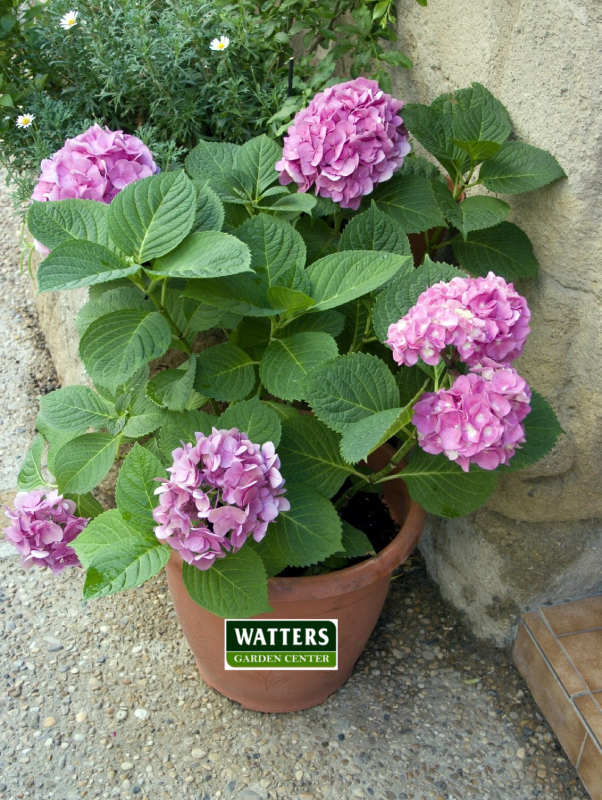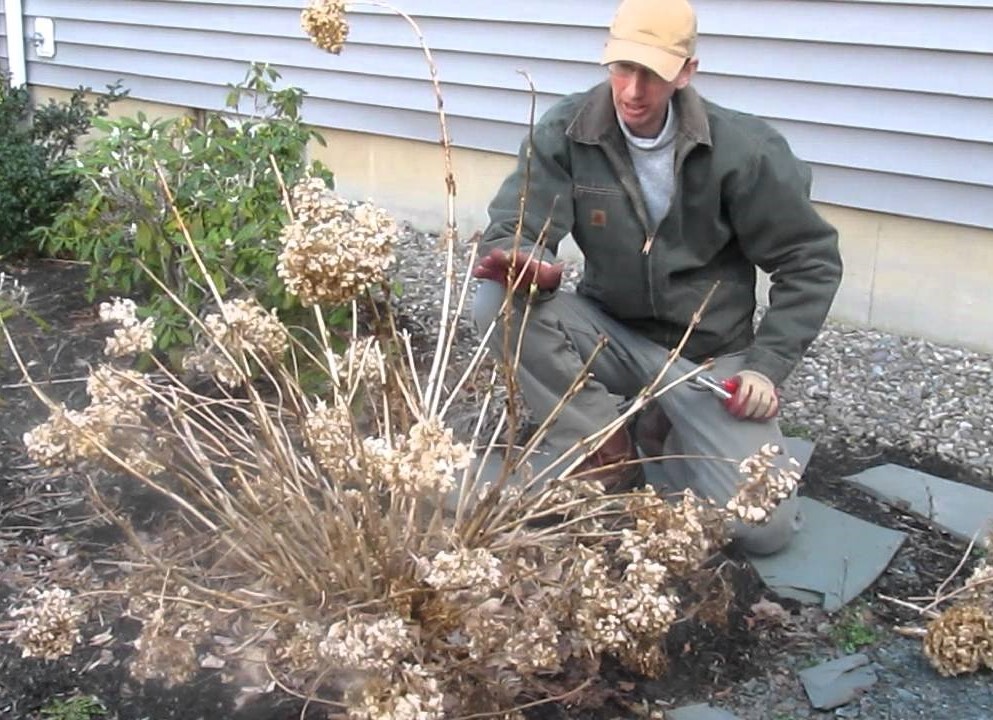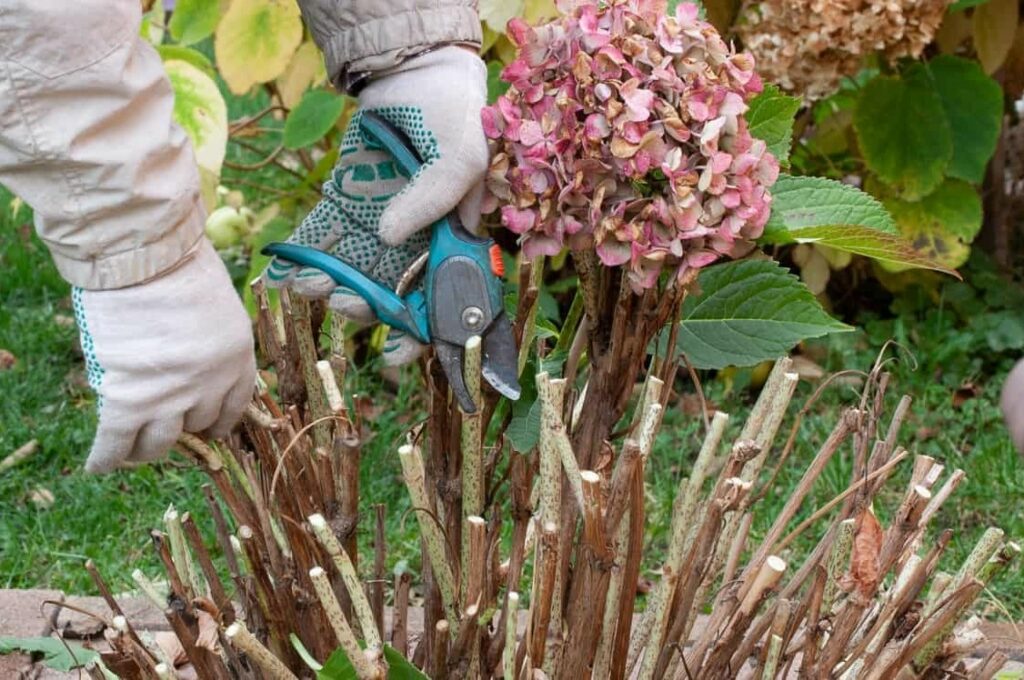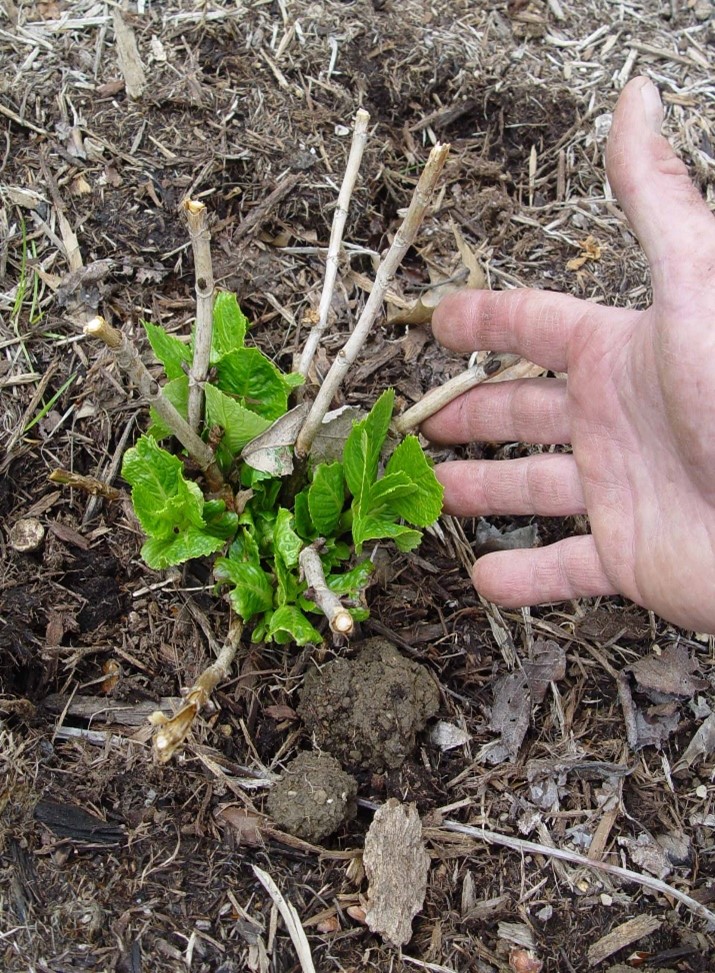by Ken Lain, the mountain gardener
- What month do you cut hydrangeas back?
- When and how do you prune hydrangeas?
- What happens if you don’t cut back hydrangeas?
- Should you cut old blooms off hydrangeas?

Hydrangeas make beautiful focal points in the garden, and they require minimal care other than pruning and plant food. Although many hydrangeas have attractive foliage and bark, most are grown for their large, showy blossoms. If hydrangeas don’t bloom, it’s usually due to three reasons: They didn’t get enough sun, an early frost killed the buds, or they pruned at the wrong time.
According to the six different hydrangea species, how and when you prune hydrangeas varies. You need to know what species you have to prune correctly in the right season.

When to Prune Hydrangeas
OK, let’s explain. Pruning hydrangea is only complicated by flowers that bloom on last year’s branch growth or the vibrant new branches from this year’s growth. Some species of hydrangea bloom on old wood, while others bloom on new wood.
Shrubs that bloom on new growth should be pruned in the late winter to early spring before new growth emerges in spring. This maximizes the amount of new growth and the number of flowers your shrub produces. Shrubs that bloom on old growth, on the other hand, should be pruned immediately after their flowers have faded. This gives the plant plenty of time to develop wood that will be “old” by the next season’s flower buds.
Before Getting Started
Hydrangea that blooms on new wood thrives on aggressive pruning. Those that bloom on last year’s old wood require more restrained pruning. The two species that bloom on new wood, Peegee, and Smooth Hydrangeas, bloom best with aggressive annual pruning that removes 30-50% of the total mass of the shrub. The four species that flower on old wood—bigleaf, oakleaf, mountain and climbing hydrangeas rarely need pruning. Cut them back to keep their size or shape in check.
Suppose you don’t immediately know the type of hydrangea. It’s easy to determine by its leaves and flower pattern.
Bigleaf Hydrangea Pruning, Hydrangea macrophylla, has large, long 8″ serrated dark green leaves that flower from mid to last summer. Along with the large leaves, bigleaf hydrangeas are identified by the large, rounded flowers. The soil pH affects the flower color; acid soils produce blue flowers, and alkaline soil turns their big, bold flowers pink. The Bigleaf species blooms on last year’s old wood and is best pruned just after the plant is finished flowering.
This species blooms on old wood. They set their flower buds from late summer to early fall. Bigleaf hydrangeas do well with minimal pruning, except to control shape and size. Never remove more than 1/3 of their total growth. If you mistakenly prune in the spring or even late fall, it will remove the flower buds and any chance of getting blooms for a year.
When most of the flowers have faded, it’s time for pruning. Begin by pruning away stems that are clearly dead or weak. Don’t prune all the old wood because this is what keeps blooming as the new growth matures. Spent flowers can be trimmed away as they fade to keep the plant looking clean. Simply clip away the blooms using bypass pruners.

Smooth Hydrangea Pruning Hydrangea arborescens, the most recognizable variety is ‘Annabelle,’ easily identified by its huge snowball-shaped flowers produced from spring to early summer. This plant flowers on new wood, so best pruned it in late winter or early spring.
Blooming on new wood, smooth hydrangea does well with aggressive pruning. Pruning should be done in early spring to ensure plenty of flower growth. Begin by removing any branches that have been injured or killed over the winter. These branches should be cut back to the main stem or ground level.
Additional branches can be lightly trimmed to shape the plant and retain its rounded shape. Produces a large shrub with many small flower heads. “Light trimming” in this case means removing as much as one-third of each stem’s length. Hard pruning back to 12-18″ inches from the ground creates a shrub that produces fewer but larger flower heads. These flowers may be so large they require propping upright.

Peegee Hydrangea Pruning, Hydrangea paniculata, has large cone-shaped flower panicles. When they first bloom, the flowers are white or green, gradually turning pink. This type flowers on new wood, requiring late winter or early spring pruning.
Panicle hydrangea blooms on new wood and prefers heavy pruning. Prune 1/3 of their total mass. This is best done by pruning out smaller wood to ground level. Leave the larger stems and shape the rest. During the growing season, remove spent flowers as they fade. This often helps prolong the bloom season as the plant puts more energy into producing even more flowers. As soon as the flowers become unattractive, clean up the plant’s overall shape with selected pruning of branches that spoil the shrub’s aesthetics. Peegee hydrangea is an attractive shrub even after flowering is over.
Oakleaf Hydrangea Pruning, Hydrangea quercifolia, have leaves resembling oak trees. Blooming early in the season with cone-shaped flowers that start green in color that fade to pink. This species flowers on old wood, so prune immediately after it flowers.
Be somewhat cautious when pruning an oakleaf hydrangea. Prune is done to control size or shape, not to stimulate new growth. Inspect your shrub in the early spring before growth has begun. If your shrub has experienced winter dieback, prune the stems back to below the point of injury. Further pruning should wait until the plant has finished flowering. Don’t feel obliged to prune unless it is essential to maintain the plant’s size or shape. Cut selected stems back to just above the point where they meet the main branches.
Mountain Hydrangeas Pruning, Hydrangea serrata, is a smaller, more compact version of Bigleaf hydrangea. Its lace cap flowers vary in color depending on soil pH. Blooming on old wood, but its small 2-4′ foot size rarely needs pruning. If you do prune, it will be done immediately after flowering.
Pruning should be done cautiously. Blooming occurs on old wood, and the plant’s pruning needs are minimal. Any dead or winter-damaged stems can be removed to the ground in early spring before new growth has started. Major pruning is done after the shrub is done blooming. Trim back stems to a pair of healthy buds. This variety rarely requires annual pruning.
Climbing Hydrangea Pruning, Hydrangea anomala, are vigorous climbing vines with white flowers that appear in spring to early summer. The flowers form flattened clusters up to 8″ wide. Pruning is done after the flowers have faded. This is another of the varieties that bloom on last year’s old wood. Requiring little to no pruning except to control its size. This plant flowers on old wood grown during the previous season, so any major pruning you do should be done immediately after the plant flowers.
They can grow quite vigorously and might need occasional hard pruning to set boundaries for the coming season. Do this pruning immediately after the plant flowers. Most flowers occur at the top, so side trimming will have less impact on the plant’s appearance.
Until next week, I’ll be helping homeowners choose the fastest growing evergreen for their landscape.
Ken Lain can be found at Watters Garden Center throughout the week, 1815 Iron Springs Rd in Prescott, or contacted through his website at WattersGardenCenter.com or Top10Shrubs.com.

